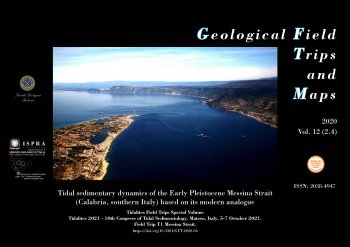
Volume 12 (2.4)/2020
Tidal sedimentary dynamics of the Early Pleistocene Messina Strait (Calabria, southern Italy) based on its modern analogue
Tidalites 2021 - 10th Congress of Tidal Sedimentology. Matera, Italy, 5-7 October 2021. Field Trip T1 Messina Strait.
DOI: https://doi.org/10.3301/GFT.2020.06 - Pages: 1-45
Sergio G. Longhitano (1), Domenico Chiarella (2), Marcello Gugliotta (3), Pascal Barrier (4), Dario Ventra (5,6) & Francesco Muto (7)
(1) - Department of Sciences, University of Basilicata, Potenza, Italy.
(2) - Clastic Sedimentology Investigation (CSI), Department of Earth Sciences, Royal Holloway, University of London, UK.
(3) - Faculty of Geosciences, University of Bremen, Klagenfurter Str. 2, 28359 Bremen, Germany.
(4) - Geosciences Department - UniLaSalle, Beauvais - France.
(5) - Department of Earth Sciences, University of Geneva, Geneva, Switzerland.
Corresponding author e-mail: sergio.longhitano@unibas.it
6 Faculty of Geosciences, Utrecht University, Utrecht, The Netherlands
7 Department of Biology, Ecology and Earth Sciences, University of Calabria, Cosenza, Italy
(2) - Clastic Sedimentology Investigation (CSI), Department of Earth Sciences, Royal Holloway, University of London, UK.
(3) - Faculty of Geosciences, University of Bremen, Klagenfurter Str. 2, 28359 Bremen, Germany.
(4) - Geosciences Department - UniLaSalle, Beauvais - France.
(5) - Department of Earth Sciences, University of Geneva, Geneva, Switzerland.
Corresponding author e-mail: sergio.longhitano@unibas.it
6 Faculty of Geosciences, Utrecht University, Utrecht, The Netherlands
7 Department of Biology, Ecology and Earth Sciences, University of Calabria, Cosenza, Italy
Abstract
The Messina Strait excursion opens a series of geological field trips associated with the 10th International Congress of Tidal Sedimentology (Tidalites), Matera, Italy, 5-7 October 2021. This guide aims at documenting a number of selected outcrops located along the eastern margin of the modern Messina Strait, in order to illustrate the sedimentary dynamics of the Early Pleistocene tide-dominated Messina Strait. Since the Pliocene, this extensional basin separated Sicily from Calabria, forming a wide non-tidal seaway. Successively, this basin turned into a ca. 10-15 km-wide and 40 km-long, tide-dominated strait during the Early Pleistocene, prior to its definitive closure following a Middle Pleistocene phase of tectonic uplift. As for today in its modern analogue, the ancient strait acted as a major conduit for marine water exchanges between the Ionian and the Tyrrhenian seas. Semi-diurnal, reverse bidirectional tidal currents flowed in phase opposition parallel to the strait margins, being subject to tidal amplification due to bathymetric restriction across the shallower strait-centre zone. This oceanographic setting partitioned the strait into specific environments. Nowadays, their sedimentary record is exposed in a series of outcrops across the western (Sicily) and eastern (Calabria) margins of the modern strait.
A series of stops along a south-to-north transect covers a total distance of ca. 20 km. Outcrops of the first day show coarse-grained deposits lying adjacent to a block-faulted central horst and transgressively overlain by cross-stratified, mixed bioclastic-siliciclastic arenites. These strata record bypass and residual sedimentation in the strait-centre zone of the ancient strait. The second day, large- and medium-scale cross-stratification exhibiting a variety of tidal sedimentary indicators are observed, interpreted as the ancient northern tidal dune field. The third day focuses on one major section representing the north-eastern flank of the ancient strait, where subaqueous canyon-fill strata, mass-wasting deposits and tide-influenced delta front-facies are exposed.
Keywords
Tidal strait, tectonic control, tidal amplification; sedimentary processes, sedimentary facies, tidal structures, cross stratification, palaeogeography.
